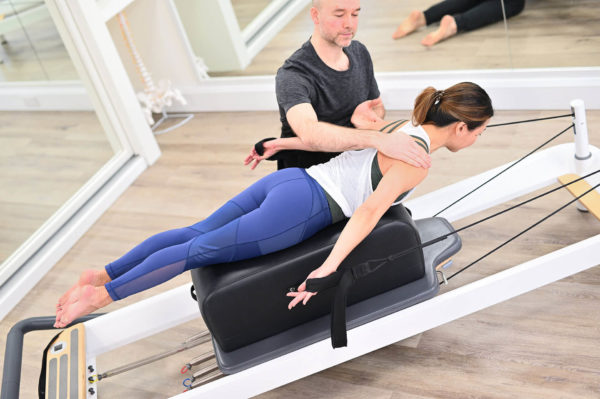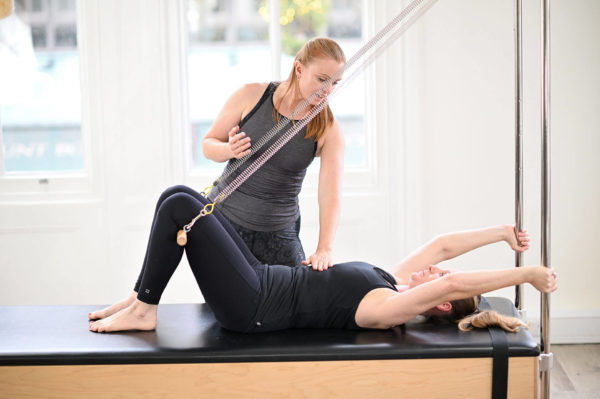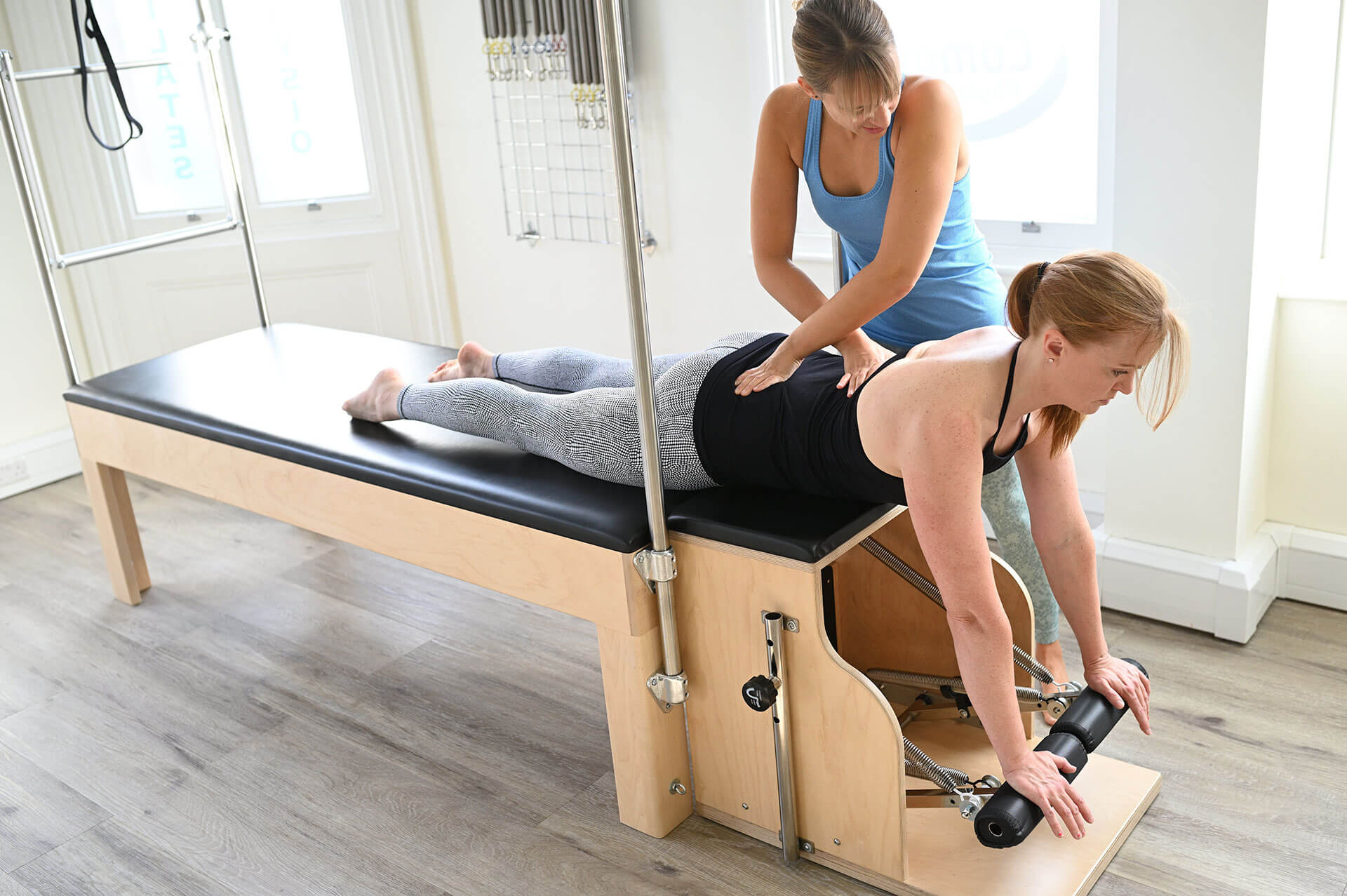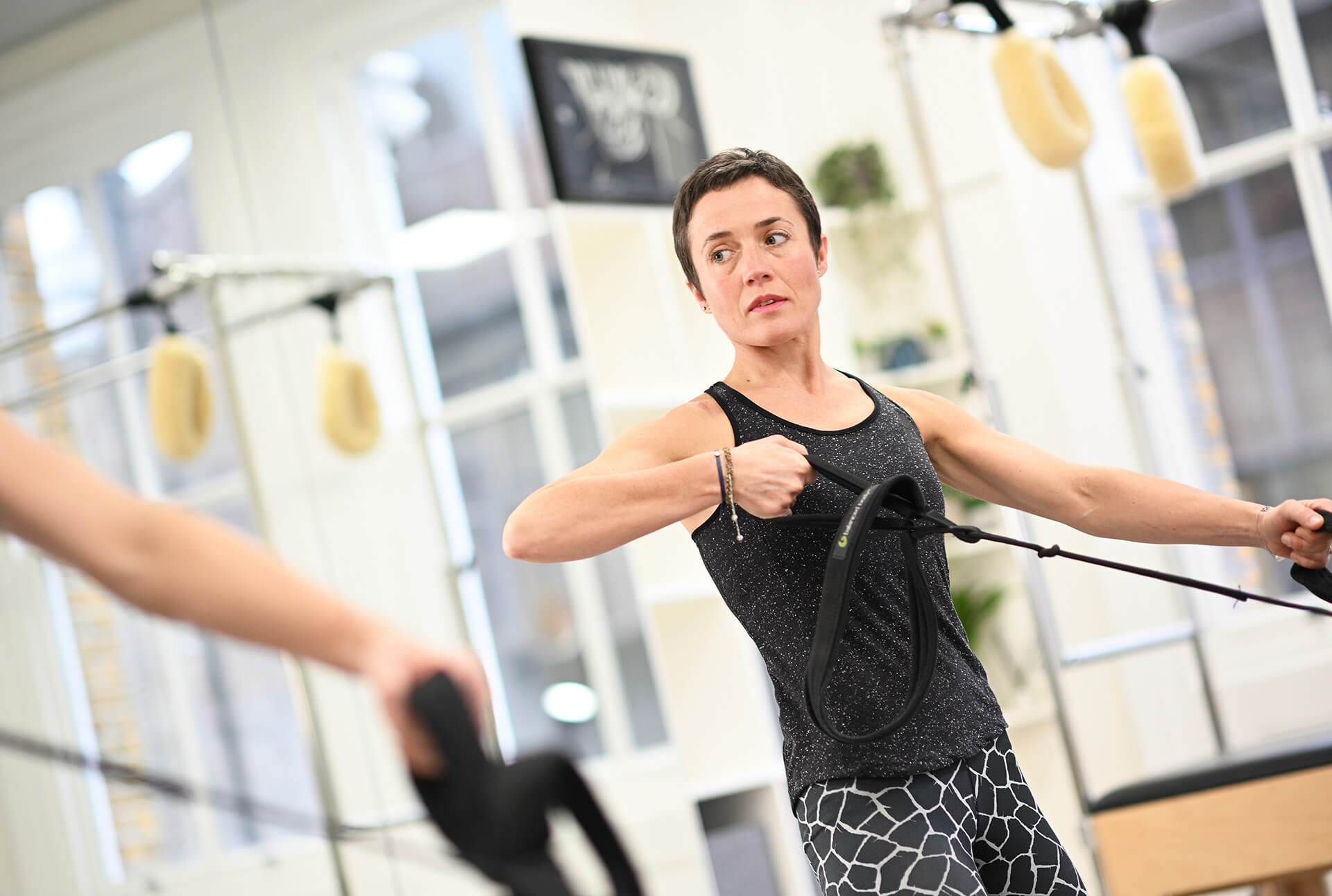Pilates and physio combined? If you’re injured, pregnant or exercise a lot, then you might’ve been to see a Physiotherapist for some treatment. This is because physiotherapy is well-known for being a great way of maintaining – or regaining – optimal physical health.
However, few people are aware of how effective Pilates (when taught by a specialist instructor) can be for prehab, rehab, and during pregnancy.
Pilates and physio work well on their own, but they do have their weaknesses. Luckily, physiotherapy’s strengths compensate for Pilates’s weaknesses, and vice versa.
This is why the experts at Complete Pilates and Complete Physio believe in using a combination of both methods. It is also why the two teams often work together to ensure a successful outcome for their clients.
Additionally it explains why many of Complete’s physios are trained on the Pilates equipment. They know just how beneficial the two practices are when used in combination and want more people to have this experience.
In this article we will discuss how Pilates physiotherapy might be the right treatment option for you with the help of Helen O’Leary, Clinical Director here at Complete Pilates and Brent Anderson, Physiotherapist and CEO of Polestar Pilates.
- Pilates and Physio – The Best Rehab
- Pilates and Physio – It’s Great For Pre And Postnatal Women
- Pilates and Physio – The Choice Of Treatment For Athletes
Pilates and Physio – The Best Rehab
Physiotherapy is celebrated for its holistic approach. This means physios consider the whole body – not just the source of pain – when treating clients.
It also involves a mixture of hands-on manual treatment, as well as the prescription of exercises for clients to do at home. These home exercises reinforce what happens in the treatment room. This makes long-term change possible.
Physiotherapy Has Limitations
But Physiotherapy has shortcomings, particularly when it comes to its rehab exercises. And this is where Pilates becomes especially useful.
Helen O’Leary, Clinical Director at Complete Pilates, explains:
“Physiotherapy has evolved over the last decade and instead of focusing solely on physical manipulation it now understands the importance of movement in recovery and uses exercise to create change and rehab injuries. However the difficulty we have as physios is that the exercises we give are all mat-based, which require a basic level of control”
“Some people simply don’t have this, meaning that it is likely these exercises will be performed incorrectly. And so, despite being essential for rehab, giving clients mat exercises is not always helpful.”

Equipment Pilates Is A Game-Changer For Rehab
This is why reformer physio is incredibly useful in the process of rehabilitation.
Brent Anderson, Physiotherapist and CEO of Polestar Pilates, points out:
“The flexibility of the Pilates equipment, which uses springs, levers and the forces of gravity, means that the difficulty level of Pilates exercises can be changed. Because of this, movements that would be impossible because of a physical condition are made possible.
“And for injured people to have these positive experiences is important on more than just a physical level. Providing a positive movement experience without pain might be the single greatest contributing factor to successful outcomes in patients as it shows the patient that they are no longer physically limited by injury or illness.”
Using the support of the Pilates equipment, such as the trapeze table and the reformer, also helps to break down movement patterns.
So why is equipment so important for rehabilitating clients? Well the equipment helps people to understand their movement patterns. Bad movement patterns are often the reason for injury. Understanding them can help people change them, and therefore get better faster.
Manual Therapy Is Vital For Recovery
Physiotherapy still plays a vital role in recovery and is why some studios (including Complete Pilates) specialise in physio-led Pilates.
Helen O’Leary explains:
“The hands-on treatment part of Physio is great because it opens a window of opportunity so that you can create change.
“Removing the physical restrictions in this way makes better movement in the Pilates studio possible. Then it is through repetition of these pain-free movements that new and better movement patterns are created.
“On top of all that, Pilates makes the injured client an active part of their rehab. This helps create awareness which is vital for a speedy recovery.”

Pilates and Physio – It’s Great For Pre And Postnatal Women
Okay, so now you know why Pilates and physio together are so effective for recovering from an injury. But the two together have other useful applications as well. Such as for women pre and post pregnancy.
It is encouraging to see that more and more people are becoming aware of the benefits of pregnancy Pilates.
Benefits that include: improving the strength of the pelvic floor and core, and creating better breathing habits. All of which can help with maintaining a pain-free body during pregnancy and in preparation for birth. After giving birth, targeted Pilates exercises can also help you regain the health of your pelvic floor.
What Is Women’s Health Physiotherapy?
At the same time, physiotherapy – more specifically, women’s health physiotherapy – is just as essential for pre and postnatal women and needs to gain more recognition.
Unlike in other European countries, postnatal check-ups with a women’s health physio (to examine things like your pelvic floor), are not routine in the UK. Because of this, few women are aware of the amazing work that women’s health physios do.
They are unaware of how helpful a visit to them can be in terms of preparing for and recovering from birth.
So what is women’s health physiotherapy? Well, they are specialist physios who are trained in areas including pelvic floor dysfunction and incontinence problems – issues that can occur after pregnancy. They can also check the condition of the pelvic floor using ultrasound.
Physiotherapy Makes Pregnancy Pilates More Effective
Pilates studios that work alongside these physios (we work with women’s health physios at Complete Pilates) benefit hugely from their expertise in the treatment of pregnant and postnatal women.
This means there is no guessing when it comes to prescribing suitable exercises. Instead, actual imaging provided by these physios informs what happens in the Pilates studio, making things like pelvic floor exercises much more effective.
Helen O’Leary points out:
“Pre and post pregnancy women’s health physio is an amazing tool to objectively look at the pelvic floor pre exercise.
“This gives us a baseline marker which can then be checked 6 weeks and 12 weeks later, once someone has started to exercise.”
And checking pelvic floor health at these different points in time is really important.
Helen adds: “Most prolapses actually occur after the baby has been born and once you start moving again,
“This means that physiotherapy is a helpful way of monitoring progress made during Pilates sessions.”
Specialist Pilates Instructors Provide the Best Care
Alongside physio, Pilates exercises can also be helpful in fixing other pregnancy-related issues, such as diastasis (the separation of the abs), that can occur during pregnancy.
This is why combining Pilates physiotherapy is the most effective form of treatment for pregnant and postnatal women.
A word of warning: for Pilates to be effective in combination with Physio for pregnant women it is vital that Pilates teachers are clinically trained specialists with extra training in this area. So check the credentials of your Pilates teacher before starting any pre or postnatal programme.

Physio and Pilates – The Choice Of Treatment For Athletes
Pregnant women or people suffering with injuries may be obvious candidates for the physio Pilates approach. But athletes and fitness fanatics can also benefit hugely from a combination of these two practices.
And here’s why: sporting endeavours put a huge physical toll on the body.
Physio Can Be A Preventative Measure
Regular hands-on treatment through physio is therefore vital for dealing with those little niggles that are an inevitable result of exercising a lot.
As the NHS website points out physio is as much about prevention as cure and frequent treatments “can help to reduce your risk of injury or illness in the future.”
Avoid Injury With Pilates
Pilates is also very effective as a method of injury prevention.
Why is this the case? Well, Ken Endleman (CEO and Founder of Balanced Body) points out that “many injuries are caused by muscular imbalances.”
Luckily for all the keen sports people out there, Pilates exercises are specifically designed to create balanced muscles.
On top of that, Pilates also improves coordination and creates a strong trunk. All of which can be an effective way of injury-proofing your body.
Together though, Pilates and physio are even better in terms of prehab than just the one form of treatment on its own.
Hands-on physical adjustments through physiotherapy prevent wear and tear from getting progressively worse. It also works out the tensions that result from intensive physical activity. Regular Pilates can also keep aches and pains at bay by helping to maintain flexibility and mobility.
For fitness junkies or athletes, Pilates can also play an important part in the early diagnosis of a weakness that might lead to injury.
This is because Pilates on the equipment turns the body in all directions and orientations. Moving in this way shows up any limitations or imbalances, which might eventually result in something more serious. These issues can be resolved, though, using physical manipulation through Physio and exercise through Pilates.
Pilates And Manual Therapy Can Enhance Sports Performance
Importantly, physio Pilates for athletes can do more than merely prevent injury. It can also be used to improve aspects of an athlete’s game, a runner’s technique, or a gym bunny’s performance on the weight rack.
Rotational exercises or single leg work, for instance, can be used to improve aspects of a golfer’s swing or a footballer’s kick.
And this is the reason why athletes including Andy Murray and Cristiano Ronaldo swear by clinical Pilates to keep them in peak physical condition.
For fear of sounding like a broken record, if you’re looking to improve sports performance then physio-led Pilates classes are the best for getting results. This is because the specialist instructors who take these classes are taught to work with movement patterns in very specific ways. And this marks them out from your average Pilates teacher.
Pilates and Physio – Why They Work So Well Together
Physio-led Pilates is what we specialise in at Complete Pilates because we know this kind of Pilates is the most effective for rehabilitation.
We also work closely with the team at Complete Physio to make sure our clients reap the benefits of manual therapy and Pilates in combination.
So, if you’re injured, pregnant or simply want to improve your tennis game, then maybe it is time you tried out Pilates and Physio with Complete. Get in touch online or contact us on 0203 764 5668 for further information and / or advice!
You can find us at one of our Pilates studios in London and speak to us about your needs. You can find us at our studios below:
Education is key:
These blogs are designed to give information to everyone, however, it is important to remember that everyone is different! If you have not seen one of our therapists and have any questions about injuries, what you have read or whether this may be useful to you, please just ask. We are more than happy to help anyone and point you in the right direction. Our biggest belief is that education is key. The more you understand about your injury, illness and movement, the more you are likely to improve.




